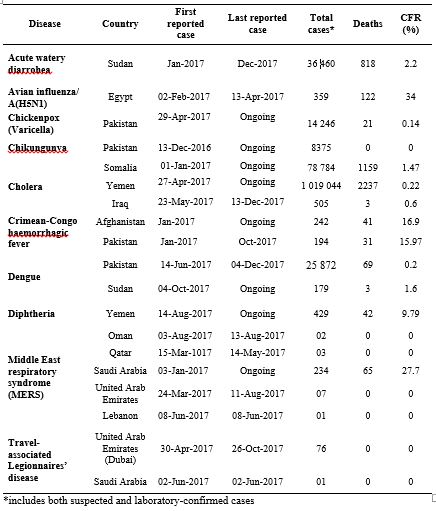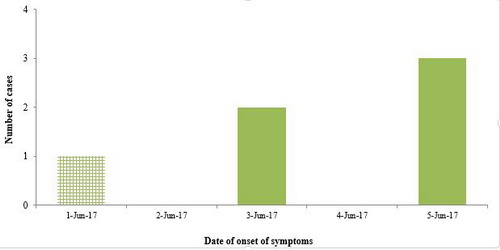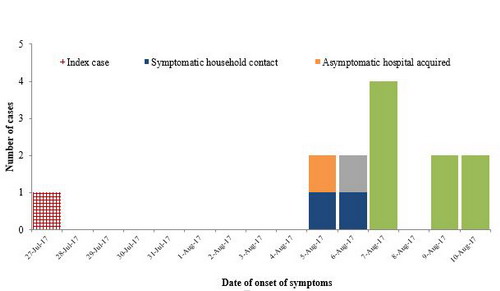12 February 2018 - Throughout 2017, the Eastern Mediterranean Region of WHO faced a number of emerging infectious diseases, some of these turning into explosive outbreaks. The emerging infectious diseases that have been reported in the Eastern Mediterranean Region in 2017 include: 1) acute watery diarrhoea; 2) avian influenza; 3) cholera; 4) Crimean-Congo haemorrhagic fever; 5) chikungunya; 6) chickenpox (varicella); 7) diphtheria; 8) Middle East respiratory syndrome; and 9) Travel-associated Legionnaire’s Disease.
The Regional Office continued to provide technical support to the affected countries to contain the outbreak and prevent geographic spread through application of appropriate public health interventions using a science-based control measure.
The likelihood of the emergence and rapid transmission of high-threat pathogen diseases has increased in recent time, as there are many countries affected directly or indirectly by acute, protracted humanitarian emergencies, which have led to an unusually high number of internally displaced persons (IDPs) and refugees living in overcrowded, overburdened spaces, with little or no access to basic health care services and environmental infrastructure. The other risk factors contributing to the emergence and rapid spread of epidemic diseases in the Region include rapid urbanization in the Region, climate change, weak surveillance and limited laboratory diagnostic capacity, and increased human–animal interaction.
1. Acute watery diarrhoea
Sudan
The wave of acute watery diarrhoea cases seen in Sudan in 2017 was unprecedented. Beginning on 21 August 2016 in Kassala state, the outbreak spread rapidly to 10 states by May 2017, 12 states by June 2017, 16 states by July 2017 and to all 18 states in the country by August 2017. The outbreak has resulted in a total of 36 460 suspected cases, including 818 associated deaths (case–fatality rate 2.24%) (Fig. 1). Some states have reported high case-fatality rates such as West Kordofan (9.62%), South Kordofan (9.96%), East Darfur (5.55%), South Darfur (4.79%) and North Darfur (4.30%).

Fig. 1. Acute watery diarrhoea cases reported during Epi week 01–52, 2017, Sudan
2. Avian Influenza A(H5N1)
Egypt
Egypt is the only country in the WHO Eastern Mediterranean Region that continues to report human cases of avian influenza A(H5N1) since the virus was first reported in the country in March 2006 (Fig. 2). A total of 359 laboratory-confirmed human cases of avian influenza A(H5N1) were reported in the country between March 2006 and December 2017. Of these cases, 122 were fatal (case–fatality rate 34%). In the year 2017, only 3 human cases of avian influenza A(H5N1) were reported including one death (case–fatality rate 33.3%).

Fig. 2. Human cases and deaths from avian influenza A(H5N1) and case-fatality rate in Egypt, 2006–2017
3. Chickenpox (varicella)
Pakistan
In the beginning of the year, the Ministry of National Health Services, Regulations and Coordination of Pakistan reported 76 suspected cases of chickenpox (varicella) including 15 deaths (case–fatality rate 19.7%) and these cases were reported from Faisalabad city, a highly populous city in Punjab province in the eastern part of the country. Afterwards, during and after May 2017, suspected cases were also reported from other districts of the Punjab Province. From April to December, 2017 a total of 14 246 suspected varicella cases with 21 associated deaths (case–fatality rate 0.14%) were reported from Punjab province. The affected districts of Punjab were: Attock, Rawalpindi, Layyah, Bhawalpur, Lahore, Faisalabd, Jhelum, Kasur, Mandi Bhauddin, Multan, Mianwali, Nankana sahib, Narowal and Sargodha. (Fig. 3). A number of cases were also laboratory-confirmed both by rt-PCR and by serology.
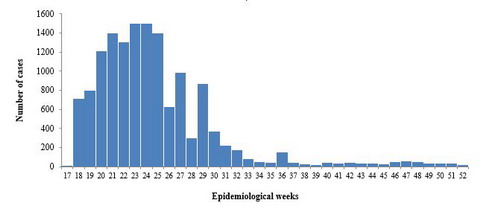
Fig. 3. Number of suspected chickenpox cases reported from Epi week 17-52, 2017, Pakistan
4. Chikungunya
Pakistan
This was the first time in its history that Pakistan reported laboratory-confirmed cases of Chikungunya. The first case was laboratory-confirmed during the second week of December 2016 by real-time PCR and since then until the end of December 2017, a total 8375 suspected cases of Chikungunya were reported from several areas of the country. The most affected provinces were Sindh and Balochistan which reported 64.3% and 33.8% of the total cases, respectively. The other affected provinces/areas which also reported cases were: Khyber Pakhtunkhwa (136), Punjab (18) and one case each form Azad Jamu Kashmir and FATA (Table 1).
Table 1. Suspected Chikungunya cases reported from December 2016 to December 2017, Pakistan

5. Cholera
Somalia
Cholera remains an endemic disease in Somalia for the past two decades. Somalia experienced multiple outbreaks from cholera during this period which were associated with significantly high mortality. In the year 2017, a total of 78 784 suspected cases of Cholera, with 1159 associated deaths (case–fatality rate 1.47%) were reported in 10 out of 18 regions in Somalia. The regions include, Middle Juba, Lower Juba, Banadir, Hiraan, Lower Shebelle, Middle Shebelle, Gedo, Bay, and Bakool Regions. (Fig. 4). The country introduced two-dose oral cholera vaccine (OCV) to contain the outbreak and between March to October 2017, a total of 1 024 948 people aged 1 year and above, were vaccinated against 2 doses of OCV. The laboratory test result confirmed the circulation of Vibrio cholerae 01 serotype Ogawa.

Fig. 4. Suspected cholera cases and deaths reported in Somalia, January to December 2017
Yemen
After a gap of 5 years, Yemen reported its first cholera outbreak in 2016. A second wave of this outbreak started during April 2017 and continued until the end of the year. During the second wave in 2017, the Ministry of Health and Population reported 1 019 044 suspected cases, including 2237 associated deaths (case–fatality rate 0.22%) from 22 governorates in the country (Fig. 5). The laboratory result of stool samples tested at the Central Public Health Laboratory in Sanaa confirmed Vibrio cholerae 01 serotype Ogawa as the strain causing the outbreak.

Fig. 5. Epidemic curve of suspected cholera cases reported in Yemen, EPI weeks 17–52, 2017
6. Crimean-Congo haemorrhagic fever
Afghanistan
The Crimean-Congo haemorrhagic fever is endemic in Afghanistan. During the last few years, the country has seen an increasing trend and cases have spread from its established foci to all other provinces as well as to the capital city-Kabul. From January to December 2017, the number of cases recorded a dramatic rise and the number exceeded those reported in previous years. A total of 242 suspected cases, including 41 deaths (case–fatality rate 16.9 %) were reported during 2017. These cases were reported from 27 out of 34 provinces in the country. The majority of the cases reported from Kabul (74 cases with 12 deaths), the capital of Afghanistan. The second province with high number of cases and deaths (66 and 8 respectively) was Herat (Fig. 6).
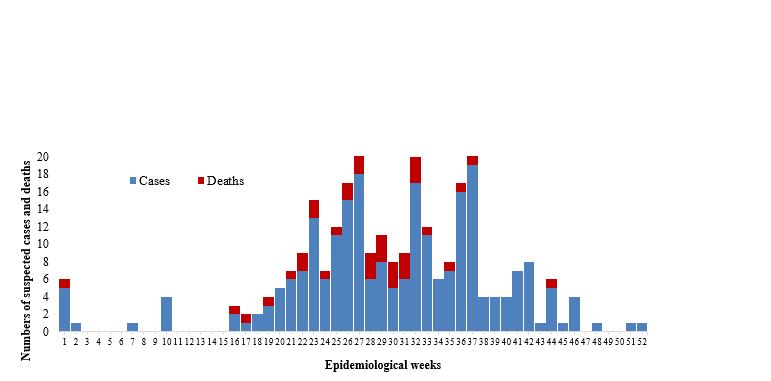
Fig. 6. Suspected cases and deaths from Crimean-Congo haemorrhagic fever reported during 2017, Afghanistan
Pakistan
Crimean-Congo haemorrhagic fever remains a public health problem in Pakistan. During the last few years, the country has encountered a number of outbreaks. Initially, cases Crimean-Congo haemorrhagic fever were reported from its established foci such as Balochistan and but now it is reported from other provinces/areas. The frequent unmonitored movement of animals and animal products remained the major cause of the spread of the virus throughout the country. From January to October 2017, a total of 194 suspected cases with 31 associated deaths were reported throughout the country. Of these total, 55 cases were laboratory-confirmed. Majority of the laboratory-confirmed cases (23) and deaths (13) were reported form Balochistan province (Fig. 7).

Fig. 7. Suspected and laboratory-confirmed cases and deaths from Crimean-Congo haemorrhagic fever in Pakistan, January to October 2017
7. Dengue fever
Pakistan
Dengue fever is endemic in Pakistan. The first outbreak of DF was detected in Karachi (Sindh Province) during 1994. After this outbreak, the country faced a number of repeated outbreaks in different provinces. The biggest outbreak that the country faced, so far, was in 2011 in Lahore (Punjab province) immediately after the floods in 2010. Over 550 000 suspected/clinically diagnosed cases were reported during that outbreak. The recent outbreak of 2017 started during the epidemiological week of 28 in Peshawar district of the Khyber Pakhtoonkhwa province. Between 28 to 47 epidemiological week 0f 2017, a total of 25 872 laboratory-confirmed cases of dengue with 69 associated deaths (case–fatality rate 0.2%) were reported by the provincial health department of Khyber Pakhtoonkhwa province. The majority of the cases were reported form the provincial capital city- Peshwar; 23 809 laboratory-confirmed cases and 64 associated deaths. (Fig. 8). The dengue virus sero-type-2 (DENG-2) was detected as the causative strain of this outbreak.

Fig. 8. Laboratory-confirmed cases and deaths from dengue fever reported in Pakistan, Epidemiological week 28-47, 2017
Sudan
The country has faced a number of dengue fever outbreaks in the past. In 2017, the cases of dengue fever was, first, reported form Kassala, East Darfur, West Darfur, South Kordofan and Red Sea states during early October 2017. A total of 179 suspected case and three associated deaths (case–fatality rate 1.6%) were reported by end of December 2017. The most affected area with more than 89% of the reported case load is Kassala state (Table 2).
Table 2. Suspected cases and deaths from dengue fever in Sudan 4-Oct-2017 to 13-Jan 2018

8. Diphtheria
Yemen
During 2017, a significant increase in probable diphtheria cases was reported between epidemiological weeks 33 and 52. A total of 429 clinically diagnosed cases, including 42 associated deaths (case–fatality rate 9.79%), were reported from 19 governorates in the country. Majority of these cases were reported from Ibb governorate (175 cases, including 12 associated deaths with a case–fatality rate of 6.8%) (Fig. 9).
In 2016, a total of 27 suspected cases were reported from the country and since the year 2000, the country used to report, on an average, 50 suspected/probable cases of diphtheria annually.

Fig. 9. Probable cases and deaths from diphtheria in Yemen, 2017
9. Middle East respiratory syndrome (MERS)
Oman, Qatar, Saudi Arabia, United Arab Emirates and Lebanon
During 2017, a total of 247 laboratory-confirmed cases of MERS were reported compared to 259, 677, 756 reported during 2016, 2015 and 2014, respectively. Of these total cases reported in 2017, Saudi Arabia reported 234 cases. Other countries reporting laboratory-confirmed cases of MERS in 2017 include United Arab Emirates (7 cases), Qatar (3 cases), Oman (2 cases) and Lebanon (1 imported case) (Fig. 10).
In 2017, a total of 8 hospital outbreaks from MERS was also reported from Saudi Arabia (Table 3 and Figs 11, 12, 13, 14, 15, 16).

Fig. 10. MERS cases reported in the Eastern Mediterranean Region by week of illness onset, 2017
MERS hospital outbreaks reported from Saudi Arabia
In 2017, 8 hospital outbreaks from MERS was reported resulting in 91 cases, including 12 deaths (case–fatality rate 13.2%). Out of these, 55 cases were asymptomatic.
Table 3. MERS Hospital outbreaks reported during 2017
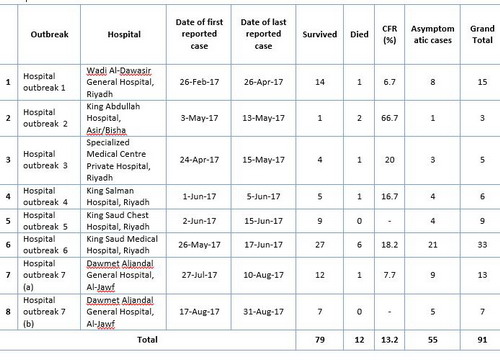

Fig. 11. MERS hospital outbreak 1, February-April 2017
Fig. 12. MERS hospital outbreak 4, May 2017
Fig. 13. MERS hospital outbreak 5, June 2017
Fig.14. MERS hopital outbreak 6, May to June 2017
Fig. 15. MERS hospital outbreak 7(a), July to August 2017

Figure 16. MERS hospital Outbreak 7(b), August 2017
Table 4. Emerging infectious disease outbreaks reported from the countries of the Region in 2017
